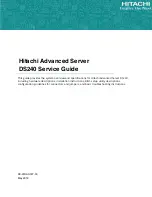
LSI Corporation
- 13 -
12Gb/s MegaRAID SAS Software User Guide
March 2014
Chapter 1: Overview
Serial-Attached SCSI Device Interface
1.2
Serial-Attached SCSI Device Interface
SAS is a serial, point-to-point, enterprise-level device interface that leverages the proven SCSI protocol set. SAS is a
convergence of the advantages of SATA II, SCSI, and Fibre Channel, and is the future mainstay of the enterprise and
high-end workstation storage markets. SAS offers a higher bandwidth per pin than parallel SCSI, and it improves the
signal and data integrity.
The SAS interface uses the proven SCSI command set to ensure reliable data transfers, while providing the
connectivity and flexibility of point-to-point serial data transfers. The serial transmission of SCSI commands eliminates
clock-skew challenges. The SAS interface provides improved performance, simplified cabling, smaller connectors,
lower pin count, and lower power requirements when compared to parallel SCSI.
SAS controllers leverage a common electrical and physical connection interface that is compatible with Serial ATA
technology. The SAS and SATA II protocols use a thin, 7-wire connector instead of the 68-wire SCSI cable or 26-wire
ATA cable. The SAS/SATA II connector and cable are easier to manipulate, allow connections to smaller devices, and do
not inhibit airflow. The point-to-point SATA II architecture eliminates inherent difficulties created by the legacy ATA
master-slave architecture, while maintaining compatibility with existing ATA firmware.
1.3
Serial ATA III Features
The SATA bus is a high-speed, internal bus that provides a low pin count (LPC), low voltage level bus for device
connections between a host controller and a SATA device.
The following list describes the SATA III features of the RAID controllers:
Supports SATA III data transfers of 12Gb/s
Supports STP data transfers of 12Gb/s
Provides a serial, point-to-point storage interface
Simplifies cabling between devices
Eliminates the master-slave construction used in parallel ATA
Allows addressing of multiple SATA II targets through an expander
Allows multiple initiators to address a single target (in a fail-over configuration) through an expander
1.4
Solid State Drive Features
The MegaRAID firmware supports the use of SSDs as standard drives and/or additional controller cache, referred to as
CacheCade software. SSD drives are expected to behave like SATA or SAS HDDs except for the following:
High random read speed (because there is no read-write head to move)
High performance-to-power ratio, as these drives have very low power consumption compared to HDDs
Low latency
High mechanical reliability
Lower weight and size
NOTE
Support for SATA SSD drives applies only to those drives that support
ATA-8 ACS compliance.
You can choose whether to allow a virtual drive to consist of both CacheCade software devices and HDDs. For a virtual
drive that consists of CacheCade software only, you can choose whether to allow SAS CacheCade software drives and
SATA CacheCade software drives in that virtual drive. For virtual drives that have both CacheCade software and HDDs,
Summary of Contents for ThinkServer RD650
Page 1: ...ThinkServer 12 Gb s MegaRAID SAS Software User Guide ...
Page 417: ......
Page 418: ......














































